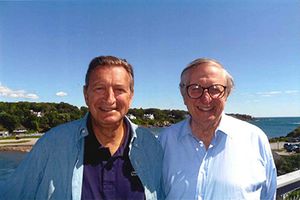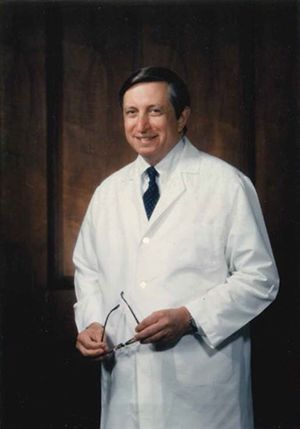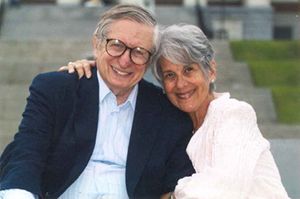By Frank G. Berson, MD

Dr. Frank and Dr. Eliot Berson
My brother Eliot grew up in Chelsea, Mass., where our father, H. Arthur Berson, MD, was a well-respected pediatrician. Dad was a skilled clinician and teacher who inspired both of his sons to pursue a career in medicine.
Although Eliot had done well in the Chelsea public schools, he decided as a junior in high school that transferring to a private school would increase his chances for acceptance at a better college and, by extension, medical school as well. He persuaded our parents to let him apply to Phillips Academy Andover for senior year. At first, he was admitted on the condition that he repeat his junior year in order to “catch up” with his classmates. Eliot, aged 16, argued that he did not have the time to give Andover two years, considering the many years of medical training ahead. The director of admissions relented and allowed Eliot to attend Andover for one year, letting him graduate with the Class of 1954.
Eliot’s characteristics of intelligence, determination, and resiliency were no more evident than on the tennis court. At Camp Wigwam for Boys in South Waterford, Maine, he was undefeated in intercamp competition, driving opponents to distraction by his ability to return everything and wait patiently for an unforced error. In one famous match during Color War, he persuaded his faltering doubles partner to leave the court, concluding correctly that his chance of winning was greater playing one against two.
His academic success at Andover was followed by even greater accomplishments at Yale College. Majoring in zoology, he was first in his class sophomore year, admitted to Sigma Xi and junior Phi Beta Kappa, and graduated summa cum laude. This propelled him to Harvard Medical School, where he developed an interest in visual science. After internship at the University of California, San Francisco, he completed residency training in St. Louis at Barnes and McMillan under Dr. Bernard Becker. There he published his first original paper, "Treatment of Experimental Fungal Keratitis" and grew into an exceptional clinical ophthalmologist.
From 1966 to 1968, Eliot served as a clinical associate in the ophthalmology branch of the National Institute of Neurological Diseases and Blindness, predecessor to the National Eye Institute. The chief, Dr. Ludwig von Sallmann, was a man whom Eliot greatly admired. In later years, lamenting on a certain informality that had pervaded academic medicine, Eliot would comment that “when Dr. von Sallmann entered the room, everyone stood up”. Eliot had the unusual opportunity to participate in “Project 710” in which hundreds of patients with retinal degenerations as well as family members were referred to the NIH for evaluation. Working with Peter Gouras and Ralph Gunkel, Eliot became an expert in clinical electroretinography.
Eliot was recruited to join the Harvard Department of Ophthalmology in 1968. He initially established an electroretinography service at Children’s Hospital but then relocated to the Mass. Eye and Ear infirmary within two years. The electroretinogram (ERG) service quickly became a major referral center. Bolstered by the philanthropic efforts of Bernard Berman of Baltimore and Gordon Gund in Princeton, N.J., a commitment was made to raise $675,000 for retinitis pigmentosa research and to secure 2,500 square feet of space within the newly constructed infirmary for a laboratory to study retinal degenerations.
 Not everyone at the Infirmary embraced this project. Eliot was viewed by some as a brash outsider who should not be in a position to control research funds outside of the long-established Howe laboratory. Nevertheless, the Berman-Gund Laboratory for the Study of Retinal Degenerations was dedicated in 1974. Eliot’s vision of a multidisciplinary laboratory at Harvard to find a treatment for retinitis pigmentosa (RP) had become a reality. Animosity toward the project and Eliot would soon fade with time and attrition. Eliot would direct the laboratory for nearly 40 years.
Not everyone at the Infirmary embraced this project. Eliot was viewed by some as a brash outsider who should not be in a position to control research funds outside of the long-established Howe laboratory. Nevertheless, the Berman-Gund Laboratory for the Study of Retinal Degenerations was dedicated in 1974. Eliot’s vision of a multidisciplinary laboratory at Harvard to find a treatment for retinitis pigmentosa (RP) had become a reality. Animosity toward the project and Eliot would soon fade with time and attrition. Eliot would direct the laboratory for nearly 40 years.
Eliot received his first research grant from the National Eye Institute in 1969, and that funding would continue uninterrupted for 39 years. He also served as principal investigator of the Retinitis Pigmentosa Center grant and received support from the Foundation Fighting Blindness for a similar duration. His initial research efforts concentrated on the characteristics of the early receptor potential in hereditary retinal degenerations, application of full-field electroretinography in diagnosing various forms of RP and quantifying progression and the impact of nutritional deficiencies in animal models. He became convinced with regard to the potential value of vitamin A in the treatment of retinitis pigmentosa, despite contrary opinions by others.
In 1984 he was awarded funding by the NEI to serve as principal investigator of a randomized clinical trial which would demonstrate by 1993 that 15,000 IU of vitamin A palmitate was a proven and effective treatment which slowed disease progression. Subsequent studies demonstrated the additional benefit of docosahexaenoic acid and lutein as supplements to vitamin A palmitate treatment.
For a Mass. Eye and Ear resident rotating through the ERG service, the experience was memorable, to which I can personally attest. Patients from just about everywhere would wait endlessly to see Eliot after testing. Many of them had been told there was no treatment for their inevitable blindness. For some patients there was the exhilarating news that, in fact, they did not have a progressive disease (or had not inherited it) based on their ERG. For others, there was the prospect of an extended lifetime of useful vision, thanks to a proven treatment.
Eliot was a methodical examiner and skilled refractionist. Although he relied heavily on the ERG (“I really only perform ophthalmoscopy as a courtesy to the patient” he would quip at Grand Rounds), he demonstrated that some patients would often benefit from a correct refraction and “a decent pair of glasses”. There was the infamous written exam for residents required to pass the rotation, although the only penalty for failure was to retake the exam. Eliot knew that the questions had probably circulated among the residents, but he never changed them. Rather, it was his way of encouraging residents to read and study.
The year 1982 was a particularly important year for Eliot. He was appointed the first incumbent of the William F. Chatlos Professorship in Ophthalmology at Harvard Medical School, a chair he would hold for the remainder of his life. After a protracted courtship, he married Kyra Kaplan, who had grown up in New Hampshire and graduated from Brandeis University. Kyra was unequivocally committed to supporting Eliot’s career, which included work hours extending well into evenings and weekends. Throughout their 35 years of marriage, they traveled the world and enjoyed summers on the Maine coast.

Dr. Eliot and Kyra Berson
Eliot realized the importance of identifying genes responsible for retinitis pigmentosa and allied conditions. Beginning with the discovery of mutations within the rhodopsin gene in patients with autosomal dominant RP, he reported on many other mutations, including the RPE65 gene in autosomal recessive RP and mutations found in Leber congenital amaurosis, X-linked and recessive RP, Stargardt macular degeneration and Usher syndrome II.
Eliot collaborated with many scientists in this effort, most notably Ted Dryja, with whom he co-authored more than 80 papers, and Carlo Rivolta of Lausanne, Switzerland. This work was integral to setting the stage for 21st-century gene therapy.
In total Eliot published 248 original papers in addition to 36 reviews. There were numerous other individuals who collaborated with Eliot, including Bruce Goldstein, K.C. Hayes and Bernard Rosner. Susan Schmidt and Michael Sandberg were early recruits to the Berman-Gund Lab. Michael, in particular, worked with Eliot for over 40 years. Eliot also recognized the importance of working with outstanding clinicians. Robert Brockhurst saw patients for years in the ERG Service, and Alexander Gaudio volunteered a day each week away from his vitreo-retinal practice in Connecticut to work with Eliot over the course of three decades.
Eliot was the recipient of numerous awards and honors during his career. They included the Alcon Research Institute Award (1988 and 1997), Francheschetti Award, International Society for Genetic Eye Diseases (1990), Taylor Smith Medal, New England Ophthalmological Society (1991), Friedenwald Award, Association for Research in Vision and Ophthalmology (1992), New York Lighthouse Pisart Vision Award (1993), Distinguished Alumni Award, Department of Ophthalmology, Washington University School of Medicine (1999), Llura Liggett Gund Award, Foundation Fighting Blindness (1999), Ludwig von Sallmann Prize, International Congress of Eye Research (2006), Award of Merit in Retina Research, Retina Society (2010), Foundation Fighting Blindness Visionary Award (2012), and Distinguished Clinical Achievement Award, Harvard Medical School, Department of Ophthalmology (2013).
Eliot’s final three years were challenging. He was abruptly forced to relinquish his clinical and administrative responsibilities, and although he continued to collaborate with colleagues and publish, he felt unable to advance his mission in a significant way. On March 19, 2017, at the age of 79, he suffered a myocardial infarction at home and succumbed to cardiac arrest.
Eliot Berson will be remembered as a kind and gentle man of exceptional intelligence and determination who advanced the field of hereditary retinal degenerations and helped countless patients with these afflictions. Just as importantly, he was a devoted son, husband and brother who is sorely missed.